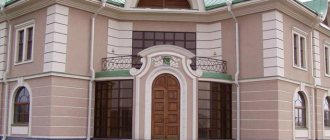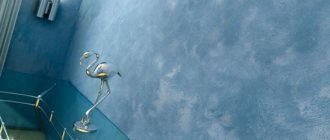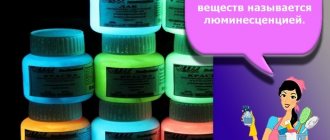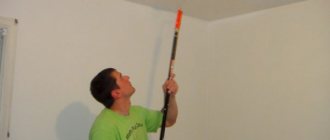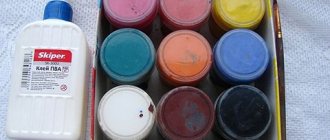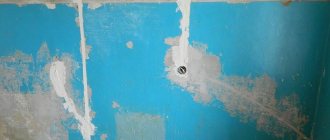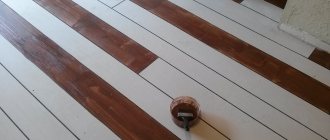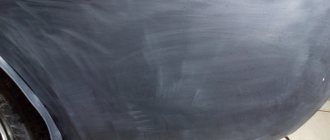Choice of solution
Previously, any paintwork material for copper contained an organic solvent. As a result, this paint had an unpleasant odor, which reduced the possibility of its use.
Modern paints are water-soluble mixtures containing natural metallic dyes. The binding elements are acrylates.
Copper-look acrylic paint is characterized by a number of positive properties:
- The composition is environmentally friendly (when drying, only moisture is released), the absence of foreign odors.
- Affordable prices, since using a water base is inexpensive.
- Aesthetic and believable “copper” appearance of the painted surface. If desired, you can give the surface an aged look.
- The painting technology is not complicated, and therefore is accessible to anyone.
- Protection of the treated surface from moisture. Moisture resistance prevents corrosion processes.
- Increased resistance to mechanical influences and ultraviolet radiation. Thus, even after many years the painted surface will look like new. If operating conditions are not violated, the service life of the surface is 10 years or more.
Note! In rooms where there are flammable substances, it is recommended to use only special fire-retardant paints and varnishes for metal. If a flame hits, they foam, making it impossible for it to spread.
Aging materials
You can achieve the effect of aged metal by using the main method - aging through the creation of a patina and the formation of abrasions. Patina is applied with special paints, but for metal, acrylic-based metallic compounds are more often used. In stores today there is a wide range of such paints; in addition to their decorative function, they also perform a protective function.
There is a choice of acrylic paints for aged metal, namely:
Thanks to modern technologies, an aged effect can be given not only to metal surfaces. Often this painting is performed on plastic, wood and plaster products.
The aging process is completed by applying a final protective layer. For this they often use:
Surface preparation
First of all, we prepare the surface. To do this, remove traces of corrosion and old paint. If this is not done, the applied layer of material will not adhere well and the coloring will become useless.
Surface cleaning is done in one of three ways:
- Mechanical. This is done using a wire brush or abrasive discs. It is recommended to use this method only for surfaces where rough processing is acceptable. Important note: mechanical cleaning should only be carried out with appropriate respiratory protection from metal dust.
- Sandblasting. Cleaning is carried out using special equipment that, under high pressure, directs streams of sand grains towards traces of corrosion, old paint and scale. The sandblasting method is effective for cleaning surfaces even in hard-to-reach places. The only drawback of this method is the high prices of equipment.
- Chemicals. Removing rust, scale and old paint layers can be done using chemical reagents. The chemistry reacts with the elements being removed, destroying them. After treatment, all that remains is to remove the remaining rust and paint with a cloth.
Regardless of the chosen method, you need to finish the job by finishing the surface - it should be as clean as possible.
After cleaning the metal, we begin priming. This increases the adhesive qualities of the surface and provides additional protection for the metal from moisture. You can start painting only after the primer has completely dried.
Painting
Further actions depend on what result should be achieved, whether the coating will be single-layer or multi-layer.
To create a monochromatic coating, we carry out the following sequence of actions:
- mix the paint with white spirit or water (according to the instructions on the package);
- We apply paint to even areas with a roller, and for hard-to-reach places and small parts we use brushes;
- let the paint dry;
- we check the quality of painting using a bright light directed at the surface, and if there are no defects, the work has been done efficiently.
If you need to make the color more saturated, apply an additional layer of copper paint. Apply the first layer of dark paint using a spray gun or brush. After this we carry out glazing, i.e. Apply an uneven thin layer of lighter paint to the now dry bottom layer.
We treat the protruding relief areas with dark paint. The final part of the finishing is treating the surface with varnish, wax or metallized powder.
The work of giving metal a copper color does not require high qualifications and can be carried out by anyone. All you need is attentiveness, accuracy and patience.
Source
Bronze painting
In the old days, many objects were made of bronze. Therefore, painting products in bronze will help to decorate the interior of the house in an old style. There are several technologies for coating metal with bronze. Let's consider the simplest options.
Giving a monochromatic effect
You can perform a single-color coating of metal with bronze as follows:
Achieving the effect of antique bronze
Decorative antique painting with a bronze effect is suitable for lovers of rare things. To do this, follow these steps:
A chemist I know showed how to copper plate any metal parts without electrolysis, in a few seconds
Hi all! I found a very simple way to copper plating steel parts without using electrolysis, and this happens in just a few seconds. The method is very simple, inexpensive and accessible, I hope you like the idea, I personally was surprised when I first saw this method!
For the copper plating procedure we will need: copper sulfate, electrolyte, distilled water and solvent.
For the experiment, let’s take an ordinary metal bolt and washer, and I’ll copper plate them!
First of all, we measure out 450 ml of water, it is important to use distilled water, without any foreign impurities!
We will need 100 grams of copper sulfate.
Electrolyte (sulfuric acid) too, 100 grams.
Pour and pour all the ingredients into a plastic bottle and mix well until the copper sulfate is completely dissolved.
Copper plating of parts
So, in order for copper to adhere well to the metal, it needs to be properly degreased, and a regular solvent does this well! But please note that polished parts are best suited for copper plating.
The bolt and washer were covered with some kind of coating, which prevented the procedure from being carried out properly. Therefore, I had to put them in electrolyte, then degrease them, and only then did everything work out. I placed them in the solvent for a couple of minutes, then took them out, moistened a clean rag in the same solvent and wiped them well.
Then, he poured the prepared solution into a glass and dipped the part into it for about five seconds and it was almost instantly coated with copper!
Source
We create an imitation of metal with acrylic paints. Silver, Bronze, Copper, Gold
Four ways to imitate metal.
Patination of a relief surface printed on a 3D printer.
We bring to your attention techniques for simulating noble non-ferrous metals. We'll show you how to use acrylic paints to give any surface a metallic texture in bronze, copper, silver or gold.
To work you will need:
- Degreasing liquid;
- synthetic brushes and bristles;
- artistic acrylic varnish;
- black acrylic primer or paint.
- Metallic acrylic paint (silver, old silver);
- universal gloss varnish.
- Acrylic paint (cobalt green light, green dark, black, Turkish blue);
- metallic acrylic paint (classic and old bronze).
- Acrylic paint chromium oxide;;
- metallic acrylic paint (old copper, classic copper, red gold).
- Acrylic paint (burnt umber, burnt sienna);
- metallic acrylic paint (old gold);
- bitumen varnish;
- shellac varnish.
- Wooden blank;
- gas burner for roasting;
- stain (ebony, rosewood);
- shellac varnish;
- epoxy resin.
Source
Selecting and applying copper paint on metal - let’s learn the main thing
Painting metal to look like copper gives the surface a special beauty and solidity. There is also an actual meaning to painting, since after high-quality processing the metal
acquires protection from excess moisture, thereby reducing the likelihood of corrosion.
Options for aging metal by decorative painting
Author: Anastasia Isakova · Published 01/08/2018 · Updated 11/26/2017
When painting metal products, two goals are pursued: protection against the formation of corrosive areas and giving the metal an aesthetic appearance. When implementing the last task, sometimes it is necessary to cover the surface in 2-3 layers. But the end result may not always be just painting. Sometimes metal products need to be given original decorative effects, for example, the appearance of an aged object. For this purpose special technologies are used. Let's try to figure out how to paint antique metal and what is required for this.
Selection of solution
Previously, any paintwork material for copper contained an organic solvent. Thanks to this, this paint
had a pungent odor, which reduced the possibilities for its use.
Modern paints are water-soluble mixtures that contain real iron dyes. Acrylates are considered binding elements.
Water- based polyacrylate-based copper paint
- The composition is environmentally safe (when drying, only moisture is released), the absence of foreign aromas.
- Inexpensive prices, because the use of a water base is inexpensive.
- A beautiful and believable " copper
" look to the painted surface. If you want to give the surface an aged look. - The painting technique is not particularly complicated, and therefore is accessible to everyone.
- Safety of the treated surface from the influence of moisture. Moisture resistance prevents rusting processes.
- Very high resistance to mechanical influences and ultraviolet radiation. Likewise, even after decades, the painted surface will look like new. If operating conditions are not violated, the service life of the surface can be 10 years or more.
Features of anti-corrosion paints
Preventing a problem is certainly easier than dealing with its consequences. But if corrosion does cover the pipe or battery, do not despair. There are special rust compounds that can be applied directly to a corroded surface. A striking example is hammer paints, which have an uneven structure, as if after being hit by a heavy object. However, you shouldn’t completely give up the opportunity to clean the surface and use a primer: copper paint on metal (and this is the color that is most in demand) will last longer on the treated surface. What are the requirements for paints?
- A textured surface that allows you to hide the unevenness of the metal.
- Large selection of colors for different rooms.
- Waterproof, fireproof, durable.
- Environmental safety, no emissions when heated.
- High adhesion, ease of application, ease of maintenance.
- Preservation of properties and appearance at any temperature.
The most popular are silver and gold metal paints, which blend well with any decor. But there are many more shades of specific coatings, so the customer can choose a color to suit his taste. The main thing, of course, remains performance characteristics: it is important that the compositions are aesthetic, non-flammable, durable and inexpensive. These are the types of metal paints you can choose from our company. We invite you to visit: come, call, experienced managers will tell you about the nuances of this or that composition, recommend the best option, and help you place an order for home delivery.
Why paint metal?
In everyday life, the most pressing issue is the protection of outdoor iron structures: metal does not like high humidity, under its influence it oxidizes and begins to deteriorate. If the iron is not protected, the structure will quickly lose its original strength.
The process of processing iron surfaces is not as simple as it might seem at first glance:
- the metal has a smooth surface, which means it has very low adhesion to any paintwork materials;
- Not all paints can protect against water.
In order not to waste money and buy a material that is guaranteed to protect your gate or canopy base from the effects of precipitation, let’s look at the proposed compositions.
The result of poor-quality metal painting will be a damaged structure after a short time.
How to age metal yourself?
The choice of method for creating an interior style, which assumes the presence of traces of antiquity in the design, is quite wide. For connoisseurs of this style, it is not always affordable to purchase real old items. The way out of this situation is to imitate ancient metals. How to properly paint antique metal with your own hands? Coloring is carried out in stages:
Important! If non-metallic surfaces are being processed, then it is necessary to take a responsible approach to the choice of primer composition to achieve reliable adhesion with metallized paints.
On video: master class on applying patina to forged metal.
Copper pipes and types of materials for painting them
During repair work, it is necessary to check the condition of the pipes and evaluate the quality of their surface. Although the pipeline made of copper elements is not subject to rust, you want it to be painted in the same color scheme of the room. Moreover, the paint will serve as protection against external damage.
Alkyd enamel is used to paint copper heating pipes.
To paint copper pipes, you can use different types of enamel. These paints differ from each other in characteristics and their ingredients.
These paints include:
- Alkyd enamel has a structure that is resistant to various impacts. Moreover, it can withstand high heating temperatures (over 100 degrees). However, there is also a negative point - a strong unpleasant odor. It can be maintained until the paint has completely dried.
- Water-based paint has a short drying time and does not emit an unpleasant odor. But it has a short service life.
- Acrylic paint - its main components are organic solvents. It has a glossy shine and does not lose its color with prolonged use. But its application requires additional surface preparation.
Antique Brass Painting
Textured metallized compositions can transform a product, giving it an imitation of brass. The processing technology is almost no different from those provided above. The surface is pre-cleaned, sanded and degreased. For aging, a technique of decorative painting to imitate brass is used.
The application process is carried out as follows:
As you can see, designer antiquity is achieved in simple ways. When doing work with your own hands, paints that create the necessary effect of a bronze, brass, or copper surface help you get the desired result.
Applying patina to metal - cheap and cheerful (1 video)
Source
Primer
These compositions are not decorative and should not be used as a finishing coating. The primer only prepares the surface for painting, adding a layer of additional protection. The use of a primer is quite important, since it performs several functions at once:
- enhances the adhesion of metal to the finishing layer;
- prevents the oxidation process;
- enhances the protective properties of paint;
- reduces the consumption of the main coating material.
There are a great variety of primers for metal on the construction market, but before processing the structure, it is important to understand what problem should be eliminated and what properties of the paint should be enhanced. Let us highlight the main types of primers for metal and describe what they are used for.
The composition of the primer depends on the degree of damage to the metal
Table 1. Types of primers (characteristics)
| Primer type | Brief description of the composition |
| Passivating | They transform the metal into a passive state in relation to the environment. The main active substance is chromates, the nuance is in their quantity in the composition. A low percentage of chromates in the primer will have the opposite effect and speed up the corrosion process. |
| Insulating | Form a thin protective film on the surface of iron. Usually made on an epoxy or alkyd base. A very budget option, recommended for use on ferrous metals. |
| Phosphating | Such primers are essentially passivating, but are suitable for work on non-ferrous metals. In everyday life, they are best known as zinc primers, because they are most often used for processing galvanized iron. |
| Tread | The mixtures contain phosphoric acid and form a protective film. Suitable for working on surfaces damaged by corrosion. |
| Inhibitory | New compounds. They are even produced on a water basis, for this reason they are easy to use. Slow down the process of corrosion that has already begun. |
Using a primer will not only protect the metal from corrosion, but will significantly extend its service life.
Important! Primers can have different chemical bases and it is important that the composition does not conflict with the material of the main decorative coating.
Primers for metal are always colored so that the treated area is clearly visible
Pipe painting process
Heating systems are rarely painted. The average period between paintings is 5-7 years. This work must be performed at the final stages of repair work. To avoid staining the floor and walls, they must be covered with plastic film or paper. It is better to choose a dark enamel color, then heat transfer will be much more effective.
Brushes for painting: a – flywheel; b – whitewash; c – maklovitsa; g – handbrake; d – flute; e – trimming; g – panel.
The process of applying enamel can be performed in several ways:
- Applying a new layer of enamel over the old one is used when the previous coating lies flat and has no chips, cracks or sagging.
- If small cracks or chips appear on the old coating, you need to remove them using coarse sandpaper. This process is carried out until a flat and smooth surface is obtained.
- In the event that the old paint is completely peeled off, it is necessary to carry out its final removal. After this, a layer of soil must be applied to the surface of the pipe.
To ensure high quality pipe coating, oily materials should not be used, since high liquid temperatures in hot pipes will lead to darkening of their surface. It is necessary to take into account that the paint will not be absorbed into the copper, so you need to shade it well on the surface. To simplify this process, you can use a paint sprayer.
To perform high-quality painting, you need to use a preliminary primer. It only needs to be applied to a prepared surface. Therefore, if enamel is re-applied, then after cleaning the surface you need to wash it, wipe it with a rag and dry it. The primer must be applied in a thin layer. This can be done with a regular paint brush. After this, you need to wait until the soil dries completely.
After the preparatory work, you can begin applying the enamel. To apply it evenly, you can use a roller or sprayer. You need to apply enamel in 2 layers - this will allow you to perform the work more efficiently and maintain a beautiful appearance for a long time. Drying of each layer takes about 6-8 hours.
Tikkurila Panssarimaali
The second place in the ranking was given to a Finnish product from a well-known brand. The paint is made on an alkyd base and contains an anti-corrosion pigment that eats away rust on metal. The surface does not need to be cleaned, but can be painted immediately. After drying, the metal has a semi-glossy sheen. Consumption is 8-12 m² per 1 liter. You need to dilute the paint with a solvent, but you can paint objects with a brush or spray. Application with a roller is allowed, but after it leveling with a brush is necessary. The product is available in packaging from 900 ml to 18 l. Buyers in the reviews are happy that this paint lasts up to 8-10 years and they do not have to do painstaking work to care for metal exposed on the street every year.
We included the product in the rating for its high resistance to moisture and ultraviolet radiation. Thanks to these properties, the paint can be used to paint metal roofs and gutters. The decorative layer easily tolerates snow and rain. The enamel holds color for a long time and looks rich.
Advantages
- can be applied to galvanized surfaces;
- active pigment against corrosion;
- tested in harsh Finnish climatic conditions;
- good consistency that does not leave streaks;
- service life up to 8-10 years.
Flaws
- high price;
- White spirit from the same manufacturer is required;
- There are no ready-made colors - only tinting, for which you will have to pay extra.
Hammerite 3 in 1
In third place in the ranking is a product from a Polish company. The paint is marketed as a 3-in-1 paint and is suitable for primer, mid-coat filling and topcoat. This simplifies the work and increases the protection of metal used outdoors. The new Dual Tech technology was used in the manufacture of the product, which has few analogues among its competitors. Not only alkyd resin, but also fatty wax is responsible for protecting the metal from moisture. The craftsmen in the reviews like that the paint applies without streaks and dries quickly within 2 hours. After the decorative layer has hardened, the painted elements have a glossy shine, which increases the presentation of the product. This is the best paint for finishing wrought-iron window grilles, canopies and railings on balconies to make the structures look advantageous.
We included the paint in the rating of the best due to the presence of wax in the composition. This natural component increases moisture resistance, so the metal receives double protection from rain and snow. Iron structures painted with Hammerit 3 in 1 are guaranteed to last up to 8 years without traces of corrosion. The presence of wax in the composition makes the metal less easily soiled.
Advantages
- rich color palette - 17 shades;
- the surface gets less dirty;
- water on iron structures does not spread, but is kept in drops, which reduces the area of its impact and promotes natural drainage;
- unpretentious to the method of application.
Flaws
- consumption from 73 to 180 rub. for 1 m²;
- it is recommended to degrease the surface;
- you need a solvent for dilution;
- The prints are clearly visible.
Other options
It is not always possible to understand acrylic or epoxy by name. For example, friends advised using hammer paint or rust enamel for painting. Let us describe the most popular compositions, their constituent substances, and, as a consequence, the properties of paints and varnishes.
Hammer paint
Another name for paint is blacksmith paint. The composition can have a different base, such as alkyd, acrylic or epoxy. Sold most often in cans, after application it forms a very characteristic coating, visually reminiscent of a surface beaten with a hammer, hence the name.
Recognizable effect: hammer paint on metal gates
The effect itself is achieved by adding low-grease aluminum powder to the base paint. In fact, all the properties of the paint depend on what composition was taken as a basis. And the hammer effect has its advantages:
- perfectly hides small surface defects;
- improves thermal characteristics;
- increases resistance to water and temperature changes.
On a note! Aluminum powder only enhances and improves the properties; the main level is set by the forming substance of the paintwork material.
Anti-corrosion compounds
Another common name is rust paint. Epoxy one-component compositions that significantly reduce the cost of metal stripping work. These paints contain anti-corrosion additives that provide durable protection against rust and at the same time create a decorative coating. Paints can be glossy or matte, but this does not change their performance properties.
- Such compositions can be used in a wide temperature range from -20 to + 80°C, which makes it possible to paint communication systems associated with water supply.
- Before application, the metal does not require special cleaning or priming, and the result is a durable coating that is resistant to moisture and dirt.
- Manufacturers claim a service life of about 8 years. In fact, the paint lasts longer, only slightly reducing its protective qualities.
The compositions have disadvantages, and the main one is the price. In addition, this type of paintwork material cannot be used to process surfaces that are in direct contact with drinking water.
Anti-corrosion compounds form a dense film on the metal surface
Rubber paint
Acrylic composition option. In appearance it resembles liquid rubber or mastic, but the technical characteristics of the finishing layer differ from rubber. Working with this composition is quite simple; it is non-toxic, because it is water-dispersed. At the same time, the paint contains certain additives that give the paint layer the following properties:
- elasticity,
- high strength,
- resistance to low and high temperatures (range -60/ +50°C),
- not susceptible to high humidity.
The paint does not require special surface preparation before application. It is an excellent waterproofing agent. Due to this property, it is very often used for painting metal roofing materials.
Rubber paint is an excellent material for treating metal roofs.
In a special article, we will consider all the characteristics and features of the use of rubber paint, which has recently appeared and has already won the trust of both professional builders and ordinary people.
How to choose the right solution
When choosing a solution, it is important to familiarize yourself with the characteristics of the main materials.
The most popular substances include:
- Patina is considered the most popular option for copper products. A greenish oxide film often forms on this. Patina helps to recreate a touch of antiquity and change the color of the product. Zinc primer will provide additional protection.
- Semi-gloss paint – helps highlight the attractiveness of the metal, which is important for artistic forging products. When painting indoors or outdoors, anti-corrosion treatment will be required.
- Hammer paint - makes it possible to achieve a stylish structured effect. On the surface of the metal, hammer substances create the appearance of beautiful embossing. Such materials are used for the restoration of cars and motorcycles. They can be used to decorate interior and landscape elements.
See also
The best brands of paints for escape routes and the differences between KM1 and KM0, how to choose
Types of paints
The question of which paint to choose for painting metal can be confusing. Modern hardware stores offer a very wide range of compounds designed for metal work. Let's organize all paintwork materials, dividing them by composition and performance characteristics.
What you should know about the paint you plan to use:
- Application area. The paint is intended for work inside a building or can easily withstand external application, that is, temperature changes and high humidity.
- Toxicity level. There are probably no completely safe compositions for painting metal. This is due to the properties of iron itself. But you should still know how toxic the material is in order to use the correct personal protective equipment.
- Thermal stability. This quality will be especially relevant if a heating system or chimney is planned for painting.
- Chemical inertness. All paints can withstand exposure to active chemicals to varying degrees. Decide how important this indicator is in your case.
Metal paint for exterior use allows you to protect the surface from the aggressive effects of precipitation, sun and temperature
. After the list of the most important qualities has been determined, we move on to the choice.
Oily
This type of paint is made on the basis of drying oil, so the composition is quite environmentally friendly and does not have a strong odor. Oil paint has gained particular popularity due to its low cost. This is where the advantages of oil paints end.
The disadvantages include:
- the shortest service life, the coating will require updating after 2 - 3 years;
- exposure to UV rays; in the sun, paint quickly loses color saturation and gloss;
- minimal anti-corrosion characteristics, the metal is practically not protected from moisture and continues to rust even under paint.
When used outdoors, the coating will quickly lose its strength and shine; it is only suitable for a short-term solution to the problem.
Oil paints create a beautiful, but short-lived coating
Nitra
The first thing that comes to mind when mentioning nitro paints is a terrible acrid smell. In many countries, nitra is prohibited for use. In Russia, the places of its use are limited by law. The composition cannot be used for work in preschool institutions, hospitals, schools, and sanatoriums.
The material is very toxic and flammable. Working with nitra indoors without strong ventilation is hazardous to health. This type of paint is susceptible to moisture. As a result of working in high humidity conditions, whitish spots will appear on the decorative coating.
- very short drying time, literally a few minutes;
- does not require a diluent, the compositions are sold ready for use;
- low material consumption and low cost.
Currently, nitro paint is most often sold in cans, which simplifies the process of applying the material as much as possible.
Nitro enamels have a fast drying time
Alkyd
Well-known PF enamels based on alkyd - pentophthalic varnish. This base creates an excellent, durable protective layer. Enamel has undoubted advantages:
- resistance to precipitation and temperature changes,
- formation of a layer with high anti-corrosion qualities,
- long service life of the coating,
- low cost.
On a note! Initially, PF enamel was created specifically for processing metal surfaces. Professionals advise that when painting iron, buy paint produced in accordance with GOST, and not in accordance with technical specifications.
The paint has few shortcomings, but they are very noticeable. The compositions have a sharp, unpleasant odor, which immediately indicates that the paint is toxic and burns well. The choice of color for alkyd coatings also has some limitations.
Alkyd compositions are distinguished by their versatility: the same paint is suitable for working on concrete and metal
Acrylic
Acrylic compounds have already proven themselves in working with concrete and wood, but they began to be used for metal processing not so long ago. The problem was that acrylic is diluted with water, and metal rusts from water. But this type of paint creates an excellent durable layer that can withstand high temperatures and does not change color under ultraviolet light. Special additives were added to the composition, which neutralize the process of interaction of metal with water, and acrylic took its special place in metalworking.
Advantages of acrylic paint:
- environmentally friendly, safe, non-toxic;
- easy to apply;
- unlimited design and color solutions;
- long service life;
- high anti-corrosion resistance.
For the first time after finishing work, the tool can be easily washed off the paint with plain water. This greatly simplifies the use of household spray guns to apply material to the surface.
Acrylic compounds are non-toxic and therefore safe to use
Epoxy
For household use, two-component formulations are more often used. It is the difficulty of mixing and the short lifetime of the composition that limits the possibility of using the composition. In addition, paints are quite expensive. Another disadvantage is the toxicity of the material.
At the same time, the advantages of epoxy coating are undeniable:
- high level of strength;
- elasticity of the coating;
- almost 100% chemical inertness;
- excellent adhesion;
- not maintaining combustion processes;
- minimal consumption, one layer of application is enough.
On a note! Epoxy primer enamels are popular among builders because they create a coating that is resistant to gasoline, motor oil, salt water, etc.
Epoxy compounds have high chemical resistance
Pantolac Stancolac
The fourth place in the ranking is given to a Greek product made from alkyd resin and synthetic additives. The product is weather resistant. The paint can be spread over the metal with a roller or brush. When using a spray gun, you will need a nozzle with a diameter of 4 mm. In order for the decorative layer to last up to 8 years, a thickness of up to 80-100 microns is recommended. At an outside temperature of +20º, the surface will dry for 5 hours, after which you can begin applying the second layer. No rust removal is required before painting. The consumption of the substance is 9-10 m² per liter. Complete rejection of the decorative layer occurs after 96 hours. Only the white version is available for sale, and the rest are obtained by tinting.
Our experts decided to add paint to the rating due to its high resistance to water. Under static conditions, for example, when painted metal is completely immersed in liquid, the iron will remain inaccessible to moisture for 24 hours. This is the best option for painting wrought iron fences and gates with many complex elements that retain water.
Advantages
- Suitable for steel, aluminum, copper and galvanization;
- transforms corrosion;
- high mechanical strength;
- supports surface bending up to 1 mm per meter without cracking;
- resistance to fading.
Flaws
- work can be carried out at temperatures from +10 degrees;
- it is recommended to degrease the surface;
- you need very good ventilation of the room;
- There are no ready-made colors - only tinting.
Coverage Requirements
First of all, let's decide what we want from the paint, what it should be.
- Anti-corrosion protection is required for any product made of black steel . Even in a relatively dry room, contact with moisture in the atmospheric air and oxygen will cause the metal to rust. Therefore, the new coating must be impermeable to water.
- Aesthetics . Everything is clear here: the color of the pipes should be in harmony with the design of the room as a whole. The exception is if the radiators are located in a niche, and the connections to them and risers will be hidden by a plasterboard box: here the painting serves a purely protective function.
By the way: hiding any communications with a non-demountable structure is a very bad idea. Sooner or later, both pipes and threaded connections between them and radiators need repair. It is advisable that after this the premises do not need reconstruction.
- The paint must have good adhesion to metals ; as an option, its application should be preceded by priming the base.
- Finally, the main feature of radiator paints is that they must be temperature resistant. This means not only the absence of cracks and delamination during repeated heating: the coating should not turn yellow.
Types of coatings for metal
Most metal structures are used in difficult conditions: with constant heating or high humidity, like household heating appliances, in the open air, like stairs, railings, fences in public places. It will not be possible to give a presentable appearance with ordinary water-based paint, applied even in several layers: it does not adhere well to metal, will not protect against rust, and will quickly peel off. Polyurethane paint for metal is very popular, most often used outdoors. It almost does not react to changes in humidity and temperature, and is highly durable. There are other types of coatings.
- Acrylics are universal coatings with a wide color palette. They apply perfectly, are waterproof, can withstand temperatures up to + 120 degrees, and are non-toxic.
- Oil-based compositions based on drying oil are used only for interior work, since they do not tolerate high heat and the direct effect of ultraviolet radiation.
- Alkyds are ideal compositions for ferrous metal products. They are characterized by high adhesion, good hiding power, and ease of application.
- Rubber compounds similar to bitumen used to scare off consumers with their unimpressive appearance, but today these versatile and beautiful coatings are in great demand.
